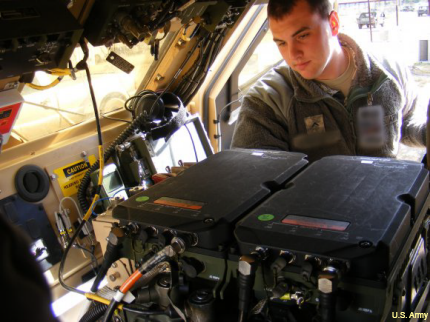Army tests satellite-independent battlefield radio
The service has developed a method for improved communications without the need for satellites by using vehicle-mounted, high-bandwidth networking radios.

A soldier operates the MNVR during a test at Fort Huachuca, Ariz.
Mid-tier networking vehicular radios, or MNVRs, allow for rapid exchange of voice messages, images and video with commanders.
"MNVR meets the need of getting data down to the soldiers," Lt. Col. Stephen Dail, communications officer for the 2nd Brigade Combat Team, 1st Armored Division, said in an Army release. "The fact that you have the ability to push data back out from locations in the field and graphically get that information back to higher headquarters—who has the expertise to examine it and potentially get information back to the Soldiers while they're still on the ground so they can react—is a game changer."
The MNVR is undergoing limited user tests at the Network Integration Evaluation to ensure it is ready to be deployed as part of the Army’s network capability set. MNVR testing at NIE involved mounting it onto Strykers, mine-resistant, ambush-protected vehicles and high-mobility, multipurpose wheeled vehicles, the Army said.
The Army wants to ensure that the MNVR is capable of handling a wide range of environments. "We are currently completing a tropic field experiment in Panama, where the radios will be subjected to high temperatures, humidity and fungus to see how well they perform in these conditions," said Eric Goodman, product manager for MNVR. "While this is not a pass-fail event, we will use the information to set a base line for future evaluations."
One of the draws for the MNVR is its independence from satellites to provide ground-level connectivity. The system uses Wideband Networking Waveform and Soldier Radio Waveform operating as a node to hop from one MNVR to another until it reaches its destination the Army release stated.
“By using these waveforms to link lower-echelon digital radios, like the Rifleman and Manpack, to Warfighter Information Network-Tactical, also known as WIN-T, the MNVR provides a significant tactical advantage for Soldiers. Since the MNVR is integrated into Army tactical vehicles, it ensures wireless communications and networking services for both mobile and stationery forces,” according to the release.
Additional testing measured the MNVR’s ability to integrate with other communication systems and radios such as the WIN-T
NEXT STORY: South Korean team wins DARPA Robotics Challenge




